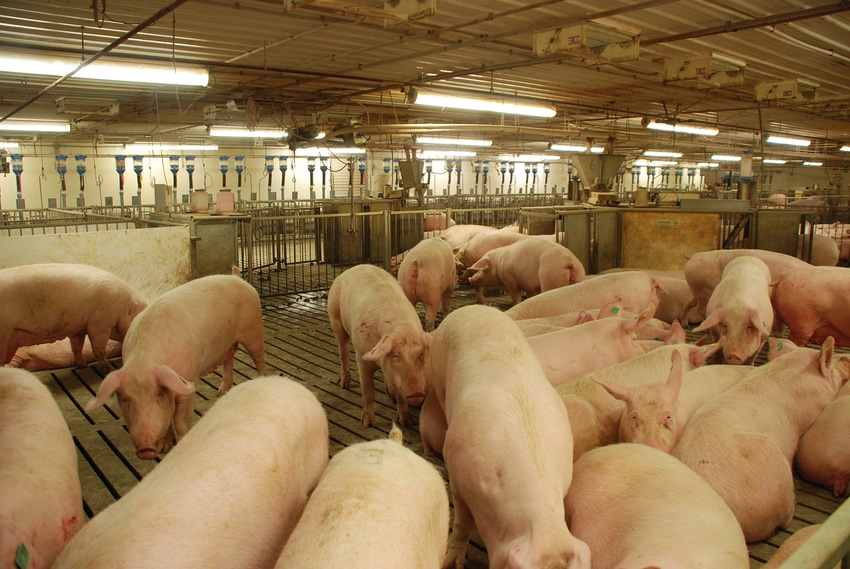If lameness is a significant herd issue, examination of affected animals by a veterinarian and collection of samples for laboratory testing can be essential factors in determining a definitive cause.
July 18, 2017

By Angela E. Pillatzki, DVM, MS, Dipl ACVP, South Dakota State University Department of Veterinary and Biomedical Sciences
According to the Merriam-Webster dictionary, lameness can be defined as stiffness and soreness of a limb that results in impaired freedom of movement. In swine production, lameness can occur at all stages of production, results in economic losses, and is associated with a large number of risk factors which can differ between individual farms. Disorders and diseases which affect the bones and joints will be the main focus of this column.
Regardless of the stage of production, a thorough investigation is needed when lameness is a significant problem in a group of animals. This requires collection of information on the past and present history of the animals, an inspection of the animals and their environment, and in many cases, a postmortem examination (i.e. necropsy) of animals that have died recently or have been sacrificed for the purpose of diagnostic assessment. Physical examination of affected individuals should be conducted by a veterinarian to characterize and localize the lameness, if possible. Additionally, when appropriate, a complete necropsy examination should also be conducted by a veterinarian to assess the full extent of the condition, to collect samples for laboratory testing and to make treatment recommendations. During necropsy, long bones, ribs and several joints are typically examined to assess the condition of the bones, cartilage and surrounding soft tissues. Joint fluid and/or joint swabs, joint tissues and samples of other tissues may be collected for laboratory testing. In some cases, submission of distal portions of rib bones for specialized laboratory testing can provide useful information in the overall assessment of bone and cartilage health.
The development of lameness in pigs is influenced by several, often overlapping factors in each stage of production. In general, sow factors, level of maternal immunity and environmental conditions influence the development of lameness in neonatal/suckling piglets. In the weaner-grower stage, pigs are typically more susceptible to infectious insults that lead to lameness; and this increased susceptibility is due to factors such as waning maternal immunity, movement and mixing of pigs, and increased stress caused by weaning. Lameness of pigs in the late grower-finisher stage is also influenced by the factors mentioned previously, in addition to nutritional imbalances.
Neonatal/suckling piglets
Trauma and polyarthritis (i.e. inflammation of multiple joints) are the most common causes of lameness in neonatal/suckling piglets. Trauma can result in fractured bones, joint dislocations or soft tissue damage; and can be caused by the sow, or during such activities as catching, restraining and transporting piglets. Polyarthritis often presents as lameness and swelling of multiple joints and is typically caused by bacterial infection. Soft, thin skin and a lack of soft tissue surrounding joints in neonatal piglets predisposes them to skin abrasions which can result in direct introduction of bacteria into joints. Additionally, polyarthritis can also be a sequela to systemic bacterial infection (i.e. septicemia). An increased frequency of septicemia and/or polyarthritis is often associated with naval ill or activities such as teeth clipping, tail docking, castration and ear notching particularly if the piglets are housed in a soiled environment. Litters from gilts may be more susceptible or more severely affected due to reduced maternal immunity.
The bacteria most commonly associated with polyarthritis in neonatal piglets include Streptococcus suis, S. equisimilis, Escherichia coli and Arcanobacterium pyogenes. However, other streptococci, staphylococci, other coliforms and actinobacilli can also cause infections. The joints most commonly affected are the carpal (i.e. distal joint below the elbow joint), elbow, hock and hip joints. Affected joints often contain an increased amount of thick and/or cloudy to opaque joint fluid, have reddened and thickened joint membranes, and may contain pale yellow, soft and friable mats of inflammatory exudate. Concurrent conditions such as pneumonia and meningitis (i.e. inflammation of the membrane lining the surface of the brain) are often present in affected piglets.
Weaned pigs
Trauma, arthritis and nutritional imbalances/deficiencies are common causes of lameness in post-weaning pigs. Foreign animal diseases should also be considered in outbreaks of lameness when the clinical history and signs are suggestive. Trauma due to improper flooring or other environmental conditions or during transport can result in lameness. If bone fractures are observed in several animals in the late-finishing stage, an underlying nutritional imbalance or deficiency should be considered as an underlying cause. Infectious pathogens are also a common cause of lameness in the post-weaning stage of production; however, the most common primary bacterial pathogens are different than those typically encountered in the neonatal/suckling stage.
Haemophilus parasuis, Actinobacillus suis, Mycoplasma hyosynoviae, M. hyorhinis and Erysipelothrix rhusiopathiae are more often associated with arthritis in the post-weaning period. These bacteria can also cause septicemia in post-weaning pigs. Septicemia and arthritis caused by S. suis can occur in post-weaning pigs as well, but is more common in neonatal piglets. Other bacteria such as A. pyogenes and coliforms can also cause arthritis, but often only affect individual animals and are not typically associated with herd outbreaks.
The joints most commonly affected by arthritis in the post-weaning period are the same as those most commonly affected in the neonatal period; and the characteristics of the joint fluid and joint tissues are similar to those described previously. The exception to this is arthritis caused by M. hyosynoviae which can affect the stifle and shoulder joints in addition to hock and elbow joints. Additionally, the amount of joint fluid is increased in affected joints, but it is usually not as cloudy; and the joint tissues are typically only mildly thickened and slightly reddened.
Nutritional imbalances and deficiencies that lead to altered bone growth and subsequent deformity of long bones and articular cartilage are important causes of lameness in post-weaning pigs. In adults, these changes can result in decreased bone strength. There are several distinct conditions, collectively known as metabolic bone diseases that are caused by nutritional imbalances and/or deficiencies and result in joint swelling and lameness. Each of these conditions are defined by the growth stage of the affected animal in combination with distinct microscopic changes observed within bones and articular cartilage. Only the two most common conditions will be covered here.
Rickets, a metabolic bone disease of growing pigs that are commonly 2- to 6-months old, manifests as swollen joints and lameness, particularly affecting the carpus, shoulder, elbow and stifle joints. During necropsy, folds and fissures in articular cartilage, and thickened and irregular growth plates may be observed. Additionally, the distal ends of rib bones may be widened; and under pressure, the ribs can be soft and bend rather than snap. Factors which predispose growing pigs to development of this condition include inadequate concentrations of calcium and/or phosphorus in the ration; an improper ratio of calcium:phosphorus in the ration; or an inadequate concentration of active vitamin D3 in the ration or due to inadequate exposure to sunlight.
In adults, osteoporosis is more common and is often associated with lameness and bone fractures. In osteoporosis, bone strength is decreased due to reduced bone mass and fractures of the long bones of the shoulder and hip joints occur most commonly. Calcium deficiency is the cause of this condition in adult pigs. Calcium deficiency can occur with inadequate concentration in the ration or with increased mobilization of calcium and phosphorus from bone during lactation in sows.
Lastly, there is another important, noninfectious cause of lameness that occurs most commonly in post-weaning pigs and it is referred to as the osteochondrosis complex. Osteochondrosis complex is a degenerative and generalized abnormality of growth cartilage that affects bone secondarily. The elbow, stifle and carpus joints are most commonly affected, and this condition can lead to the development of chronic, degenerative joint disease in adult animals. The cause of OCD is multifactorial and likely due to a combination of factors that include genetics, rapid growth rate, heavy muscling, trauma and limited activity within confinement. In some pigs, a manifestation of OCD is the separation of the head of the femur from underlying bone along the growth cartilage in the hip joint. This condition is referred to as epiphysiolysis and it typically results in sudden onset of severe lameness.
There are several important infectious and noninfectious causes of lameness that affect pigs at all stages of production. If lameness is a significant herd issue, examination of affected animals by a veterinarian and collection of samples for laboratory testing can be essential factors in determining a definitive cause.
You May Also Like



